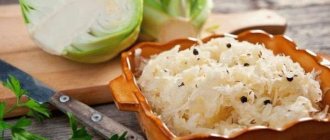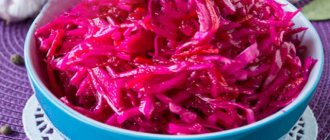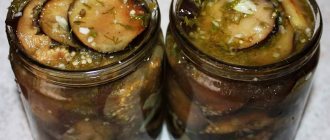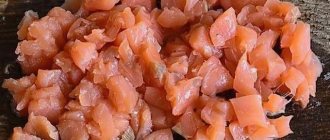Sauerkraut with beets in jars in large pieces
It is very convenient to prepare sauerkraut with beets, chopped into pieces in jars, because... at the same time, it does not lose its appearance, remains juicy, crispy, and also changes color to bright burgundy. Sealing is also stored conveniently and for a long time, because a tightly closed lid prevents the development of bacteria in the jar and spoilage of the product.
All we need for cooking:
- A head of cabbage, small in size, about two to three kilograms;
- Large beets;
- Large carrots;
- Garlic, one large or two small heads;
- A little more than half granulated sugar;
- Two tablespoons of ordinary table salt
- A few black peppercorns;
- Sunflower oil - depending on the number of cans, one tablespoon for each;
- Several bay leaves;
- Half a glass of vinegar;
- One liter of drinking water.
Preparation:
- We start with cabbage. We wash it thoroughly and begin to peel off the very top layer of leaves.
- Attention to housewives: I do not recommend using early varieties of cabbage for cooking. Onan will not give any crunch when preserved and will be too loose and not juicy. In addition, later heads of cabbage will contain more useful substances.
- We cut the head of cabbage into two equal parts, and then each of these parts into another six to eight equal parts so that we get rectangles.
- We wash the red beets. The fruit should also not be very young, otherwise you risk ruining the dish. Peel the beets and cut them in half, and each half into medium-sized slices.
- Wash and peel the carrots. There are two options for slicing a vegetable: grate it on a coarse grater or, like beets, cut it into slices. I usually use the second method, but it's up to you.
- Wash the garlic and cut it lengthwise into thin slices. Advice for you: I do not recommend using a garlic press in this recipe, because in this case the garlic does not convey its flavor and aroma properties very well.
- Combine all the chopped vegetables in one large saucepan and mix thoroughly so that the mixture in the jars looks uniform. Place vegetables in jars.
- This step is about preparing the marinade. Add sugar, salt, pepper, bay leaves to the water and leave to simmer for about five minutes. Add vinegar and the marinade is ready. Fill the resulting liquid to the brim of the jar, close the lids, wrap it in a blanket and allow it to cool to room temperature.
For those who want to see with their own eyes how to prepare this dish, I suggest watching the video:
If you wish, after two days you will be able to enjoy what a very tasty sauerkraut with beets you have made. Bon appetit!
Georgian sauerkraut with beets
There are a great many options for sauerkraut with beets; each country can offer its own unique recipe. Now I want to share with you a method of preparing Georgian sauerkraut with beets, which was invented by the inhabitants of this country.
Ingredients to prepare:
- Medium-sized cabbage weighing approximately 2.5-3 kilograms;
- Large beetroot weighing approximately 1-1.5 kilograms;
- A few red peppers to add spice to the dish;
- Two small heads of garlic;
- Two bunches of fresh celery;
- Table salt - two to three tablespoons;
- Drinking water – about two liters.
Let's start cooking:
- The unusual thing about this starter is that the marinade, when poured into jars, is not hot, but rather cold. Therefore, the first cooking step is not about preparing the vegetables, but about preparing the brine. Place a pan of water on gas and begin to boil the water. After bubbles appear in it, add two tablespoons of table salt, cook for literally one minute and turn off. Let the salt water cool to room temperature.
- Let's move on to preparing vegetables. Carefully wash the cabbage fork and cut it into two equal parts. Cut each of the resulting halves into pieces into three or four equal parts. Small pieces will help the cabbage to absorb beet juice well and color during fermentation.
- Carefully wash and clean the beet fruit. Cut it into thin circles. This can be done using a grater, or you can do it manually, whichever is more convenient for you. I use a grater, then the circles are thin and of equal size.
- Wash and peel the garlic and red pepper. You should be careful with garlic; I do not recommend putting it through a garlic press; it is better to cut it into several pieces so that it better preserves its taste and aroma. Cut the red pepper into rings.
- We take the jars and start adding vegetables. First beets, then cabbage, and so on in order, also adding garlic, pepper rings and celery, previously mashed in your hands, the topmost layer is again beets.
- Fill the jars with brine up to the neck, add a little more salt to taste and close the lid.
In three to five days the dish will be ready, and you can please yourself and your loved ones!
Best Recipes
Cabbage and beetroot appetizer is loved by people of different countries and some of them have their own national recipes.
Sauerkraut with beets in large pieces
You can ferment cabbage in large pieces either with or without the addition of vinegar, depending on personal preference. In the first case, the jars can be sealed, which will increase the shelf life of the snack. But the second method is more preferable for those who follow a healthy diet.
Sauerkraut with beets in a jar
This is one of the simplest and most popular recipes.
How to cook:
- Place beets, cut into small cubes, at the bottom of a three-liter glass jar.
- Separately, chop the cabbage and grate the carrots, as in the classic recipe.
- Mix the chopped vegetables with salt in a bowl and place them in a jar, lightly compacting each new layer 2-3 cm thick.
- Cover with gauze and place the jar on a plate into which the juice formed during the fermentation process will drain.
Every day, the vegetable mixture should be pierced with a long wooden stick to release gases.
Instant recipe
The appetizer will quickly acquire the sourness inherent in sauerkraut if you use vinegar, and it is better to use apple cider vinegar for this purpose. Prepare the marinade by boiling water with salt, black peppercorns, bay leaf and a small amount of vegetable oil. Before turning off the heat, pour vinegar into the boiling mixture.
For 1 liter of water:
- 2 tbsp. l. salt;
- 1 tbsp. l. refined vegetable oil;
- 6 tbsp. l. 9% vinegar;
- 3-5 black peppercorns;
- 1-3 bay leaves.
Place cabbage cut into pieces, slices of beets and garlic, and spicy herbs, slightly mashed in your hands, into a container. Pour over hot marinade. After a day, the quick snack is ready to eat.
See also
Recipes for pickling cucumbers with honey for the winterRead
In Georgian
The peculiarity of the Georgian snack is that you first need to boil water with salt and spices and cool the resulting marinade.
Cut the head of cabbage into pieces and the beets into slices. The proportions of cabbage and beets are approximately 3:1.
You will also need:
- celery greens – 1-2 bunches;
- garlic – 1-3 heads, cut into thin slices;
- hot pepper - 1-2 pods, seeded and cut into slices.
Place cabbage and beets in layers in a jar, sprinkle with herbs and spices, pour in cooled brine and press down on top with a small weight. Leave in a warm place for several days until the fermentation process is complete.
In Armenian
This recipe is very similar to the Georgian one, only it needs to be supplemented with carrots and cilantro. Vinegar is also not included in it, but for flavoring take a little cinnamon.
In Korean
Korean sauerkraut has a spicy taste; hot pepper is added to it, and in addition, the marinade is prepared with vinegar.
Vegetables are prepared in the usual way and placed in jars along with garlic. Pour in hot marinade and allow to cool. After a short amount of time, this snack is ready to eat.
In Gurian
The Gurian recipe is a variation of the Georgian one, the difference is in the use of hot marinade instead of cold. Intersperse pieces of cabbage with slices of beets and cloves of garlic, pour hot marinade over them and, after cooling, store in a cool place.
Recipe for sauerkraut with beets, like my grandmother’s - with vinegar
Recipes for sauerkraut with red beets with and without vinegar have the same number of fans, so today I will tell you about both options, and you decide for yourself which one will become a regular dish on the table.
- We prepare the ingredients for the future sourdough. We will need: Medium-sized cabbage forks, weighing up to two kilograms;
- Two medium carrots;
- Garlic – one medium head;
- Beetroot weighing up to about 1.5 kilograms;
- Drinking water – liter;
- Granulated sugar - three-quarters of a glass;
- Two tablespoons of table salt;
- Lavrushka - two pieces;
- Unscented sunflower oil - one glass;
- A little hot pepper to taste;
- Black peppercorns - several pieces;
- Six tablespoons of vinegar.
First, thoroughly wash the cabbage fork and cut it in half. We cut each of the halves into several more identical small pieces.
Wash and cut the beets thoroughly. Cut it lengthwise into large, approximately equal-sized strips.
Wash and peel the carrots. Just like beets, we cut them into large strips.
Take a washed and peeled head of garlic and cut it lengthwise into strips or crosswise into slices, as you prefer. The main thing is not to put the garlic through a garlic press.
Prepare the marinade. Add bay leaf, salt, granulated sugar, pepper, sunflower oil to the water and cook until the mixture boils. After this, turn off the gas under it and add vinegar.
Pour the resulting marinade into the jars, cover them and leave to cool for a day. After 24 hours you will be able to taste the resulting dish.
Terms and conditions of storage
If fermentation processes are activated and occur at a temperature of +15...+18°C, then the finished product must be stored in the cold. This could be a refrigerator, basement, balcony, or other unheated room. Storage temperature - no higher than +5°C, optimal air humidity - 85–95%. The shelf life of the product in glass jars is about 2 weeks.
Making sauerkraut is very simple. Most of the ingredients are easy to find and are sold in abundance both at the market and in stores, so you can always treat your family to a new dish. The short cooking time of most of them and the large amount of vitamins in the final product are additional arguments in favor of this product.
Option without vinegar
The second option for preparing sauerkraut with beets is without vinegar. This recipe is also very popular, and I’ll tell you how to prepare it below.
We prepare the following ingredients:
- A small head of cabbage weighing up to two kilograms;
- Two pieces of small beets;
- Two medium sized carrots;
- Two pieces of garlic heads;
- Granulated sugar - level tablespoon;
- Table salt - two tablespoons;
- Four pieces of allspice;
- Half of hot pepper;
- Five laurel leaves;
- Two liters of drinking water.
Wash the head of cabbage, remove the top layer of leaves, cut into two equal parts. Place each piece on the cut side and cut into approximately 6-8 equal pieces.
Beets and carrots for this recipe should be cut into small strips. We wash the fruits and either grate or chop the beets and carrots very finely.
We fill the jars. First we put in the garlic, which has previously been chopped or crushed, then the beets, carrots, cabbage, and spices one by one.
Put the water on gas, add sugar, pepper and salt to it. Cook everything until it boils, turn it off and let it cool a little.
Now you can add the brine to the jars, close the lids tightly on top and let cool for 24 hours. The next day, open the jars and press the contents with a spoon or fork to release any trapped air. Seal the jars again and leave for four days. Very soon the sauerkraut with beets will be ready!
Sauerkraut in Armenian style
Armenia shares another recipe for sauerkraut with beets. I will tell you about the cooking features in the next recipe.
Ingredients for the dish:
- Two small or one medium forks, not exceeding a weight of 2.5 kilograms;
- One small beet;
- Garlic – one clove;
- Two pieces of chili pepper;
- Celery root;
- Three liters of drinking water;
- Half a teaspoon of cilantro;
- Pepper - a dozen peas;
- Lavrushka - two or three pieces;
- Six tablespoons of table salt;
- Half a cinnamon stick.
Preparation:
- Prepare the brine. We put the water on gas, immediately add all the spices to it, wait until the water reaches boiling point. Turn off the gas and let it cool.
- We wash the heads of cabbage, peel them from the top layers of leaves and cut them into four equal parts. Wash and cut the carrots into slices.
- We wash and peel the beets, cut them into thin slices using a grater or by hand. We thoroughly wash the roots and cut them.
- Alternately put cabbage, carrots, beets and spices into the jars. Pour the marinade over the mixture, cover with cabbage leaves and leave under a load for several days.
- After several days, we put the jars in a cellar or other cold place.
How to speed up the ripening process? - instant recipe
Sometimes you don’t want to bother with cooking for a long time, but you can enjoy crispy cabbage without a lengthy process. A quick recipe for sauerkraut with beets will delight novice housewives.
You will be interested in: Delicious candied tangerine peels: 2 recipes with photos
Required Products:
- The cabbage is small;
- Buryak 1 piece;
- Horseradish (optional) several small pieces;
- Carrot;
- Parsley optional;
- Rock salt 2 tablespoons;
- Granulated sugar 1 tablespoon;
- Bay leaves.
Almost every housewife has her own recipe for sauerkraut. But you will probably need a quick recipe when the idea suddenly comes to decorate the table with a delicious snack.
We start by preparing the vegetables. We wash and clean. Next, chop the cabbage. Today, convenient shredders are sold that simplify this process.
And now it's time for tips for quick ripening. Shredded cabbage cooks faster than chopped cabbage.
Place the cabbage in an enamel container. Grate beets and carrots, add parsley and horseradish if desired.
Mix all products thoroughly. Boil water and add salt and sugar to it. You may notice that there is no vinegar in this recipe. The fact is that vinegar makes the cabbage pickled and only the name remains from the classic recipe.
Next, you need to pour hot brine over the cabbage! Instant sauerkraut with beets recipe with visual photos will help any housewife do everything right.
Hot brine will speed up the process!
Next you need to put pressure on the cabbage, this could be a heavy pan of water. Some people keep a special and large cobblestone at home for such purposes. It is the pressure that will make the cooking process quick!
In two days the cabbage will be ready. Instant sauerkraut with beets recipe is the way to go when you need to quickly come up with an appetizer that everyone will like.
Korean recipe for spicy cabbage with beets
Like most Korean dishes, this recipe has a spicy taste, so it will especially appeal to lovers of savory preparations.
For the recipe we will need:
- Medium-sized cabbage, up to 2 kilograms;
- Small beets;
- Three or four bay leaves;
- A few cloves of garlic;
- Drinking water – one liter;
- 3 tablespoons table sugar;
- 3 tablespoons table salt;
- One-half cup of table vinegar;
- Peppercorns - a dozen pieces.
Preparation steps:
- Wash the head of cabbage thoroughly, cut it in half, and then each part into six more pieces.
- We also thoroughly wash and peel the beets, cut them into small strips or three on a coarse grater, as you wish.
- Wash and peel the garlic thoroughly, cut into several slices and slices. Place all the vegetables in a large container and mix.
- We are preparing the marinade. We put the water on gas, after boiling, add sugar, salt, bay leaf and pepper. Cook for another ten minutes, clear the water from the leaves and pepper, then pour in the vinegar.
- Place the mixture in jars and pour the marinade into them. Let the jars cool for 24 hours and then put them in the refrigerator.
Now you can try the resulting dish, bon appetit!
Is it possible to ferment cabbage with beets?
The preservative effect of fermentation is based on the formation of lactic acid as a result of the fermentation of sugar under the influence of lactic acid bacteria. Salt enhances this effect, so the brine recipe necessarily includes salt and water, and the raw materials in the manufacturing process can be vegetables, as well as spices, for example, peppercorns. Additional ingredients include carrots or beets.
The cabbage is mixed with the remaining ingredients and placed in a container under pressure. When the product is ready, it is transferred to storage containers. The choice of container depends on the volume of the final product. Store jars of sauerkraut in a cold room.











